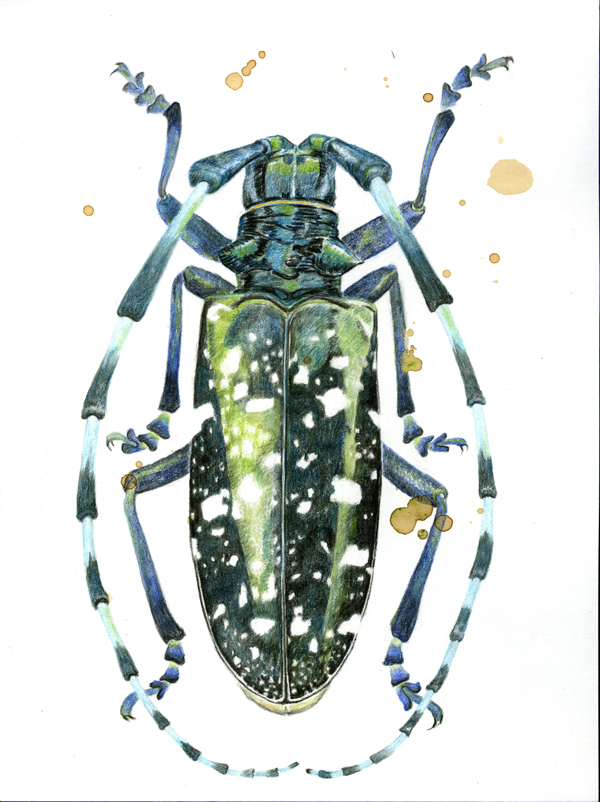Smithsonian’s National Zoo To Host CulturalDC’s SPACE4: Visual Arts Initiative, Washington, D.C.’s First Mobile Art Gallery
Artist Maggie Gourlay’s Installation Inspired by Impact of Invasive Insect Species on the United States
The Smithsonian’s National Zoo, in collaboration with CulturalDC, will host Washington, D.C.’s first mobile art gallery during ZooLights, powered by Pepco, the Zoo’s annual free holiday lights festival from Nov. 24 through Jan. 1 (except Dec. 24, 25 and 31). As part of CulturalDC’s SPACE4: Visual Arts initiative, local artist Maggie Gourlay has created “Adaptation/Migration in the Anthropocene,” an immersive multimedia installation inspired by exotic insect species that have migrated to the United States in commercial shipping containers and become conservation threats in their new habitats. Admission to the Zoo, ZooLights and the mobile art gallery is free.
“We’re excited for visitors to experience how an artist is inspired by the environment and the challenges we face to preserve global biodiversity,” said Pamela Baker-Masson, associate director of the Zoo's Office of Communications, Exhibits and Strategic Planning. “It’s fascinating to see how Maggie’s work reflects our role in transporting these tiny, destructive creatures through global commerce, like the Emerald Ash Borer beetle being studied by Smithsonian ecologists. This installation is a reminder of what the era of the Anthropocene is all about—how humans impact world.”
An artist who visually explores narratives of home, Gourlay’s installation at the Zoo highlights her concern with the human impact on the Earth as a collective shared home. “Adaptation/Migration in the Anthropocene” features visually arresting artistic interpretations of invasive insect species that have migrated across the globe to the United States—many in shipping containers transporting goods. Her multimedia work incorporates visual and auditory reminders of the symbiotic relationship between people and nature and explores how these insects adapt to and can thrive in warmer environments. At an interactive station in the mobile gallery, visitors can create and take home an original invasive-insect print made from a special-edition stamp of one of Gourlay’s “bug portraits.” The mobile gallery is open from 10 a.m. to 9 p.m. from Nov. 24 to Jan. 1 (except Dec. 24, 25 and 31).
CulturalDC's SPACE4: Visual Arts initiative presents cutting-edge artwork by local artists in a 40-foot portable shipping container transformed into a mobile art gallery. Moving across Washington, D.C., to activate unconventional venues, the SPACE4 Mobile Art Gallery connects local communities to a new exhibit by a local artist in every neighborhood it visits. CulturalDC solicited exhibitions through a competitive open-call process. Project submissions were reviewed and selected by an advisory panel composed of noted artists and arts professionals in the Washington area.
Gourlay’s art installation has a direct connection to the work of Smithsonian Conservation Biology Institute (SCBI) ecologists who study how ecosystems and the species within them respond to global changes. The Smithsonian leads the Forest Global Earth Observatory Network (ForestGEO)—the only network that applies a standardized protocol to measure and document forests all over the world. When a major event occurs, like the arrival of an invasive species, scientists are able to evaluate how the trees are affected.
Currently, SCBI ecologists are studying the extensive impact of the invasive emerald ash borer beetle on critically endangered native ash trees in a 50-acre ForestGEO plot evaluated annually through a tree census. Ten percent of the native ash trees studied at SCBI died earlier this year, and all that remain are likely to be infected with beetle larvae. This ecological research is critical to understanding tree mortality and how trees are responding to invasive species, climate change or other global factors. ForestGEO plots enable ecologists to follow the trajectories of individual trees and how those trees impact overall forest health.
Gourlay is a visual artist whose installation and two-dimensional work has been exhibited widely throughout the region. She served as artist-in-residence at the Vermont Studio School and Pyramid Atlantic Arts Center. A recipient of purchase grants from the DC Commission on the Arts and Humanities, Gourlay was a semifinalist for the Janet and Water Sondheim Prize and the Trawick Prize. She received her Master of Fine Arts from Towson University and has taught art at Montgomery College in Rockville, Maryland since 2010.
Always free of charge and open 364 days a year, the Smithsonian’s National Zoo instills a lifelong commitment to conservation through engaging experiences with animals and the people working to save them. The Zoo sits on 163 acres in the heart of Washington, D.C.’s Rock Creek Park and is home to more than 1,500 animals across 300 different species. The Zoo’s commitment to conservation, research, and education extends to the Smithsonian Conservation Biology Institute (SCBI), located in nearby Front Royal, Va. SCBI scientists and animal care experts conduct veterinary and reproductive research to save wildlife and habitats for some of the world’s most endangered animals on the sprawling 3,200-acre campus. SCBI leads the Smithsonian’s global effort to save species, better understand ecosystems and train future generations of conservationists.
CulturalDC has a 19-year history of creating affordable and sustainable artist spaces, brokering more than 250,000 square of space for artists and arts organizations in the Washington area. Each year CulturalDC works with over 1,000 artists and arts groups serving 30,000 guests through the activation of art space and presentation of contemporary visual and performing arts at the Source Theatre, and in nontraditional venues across the city.
###
Photo credit: Maggie Gourlay, Asian Long-Horned Beetle, watercolor pencil and coffee, 2017. High resolution available by request. Please contact Annalisa Meyer for photos: 202-633-3081

